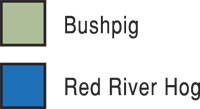 |
 |
Potamochoerus porcus
Generic name is from the Greek potamos (river) and khoiros (pig). Porcus is Latin for pig or hog.
In previous editions, the red river hog was combined with the bushpig as one species; however, Grubb has recently recognized each as a separate species, citing their morphological differences and the lack of evidence that they hybridize, and this has been generally accepted.
DESCRIPTION Shoulder height 25-30 inches (63-76 cm). Weight 120-180 lbs (54-81 kg).
The red river hog is the smallest African pig, averaging slightly smaller than the bushpig, and is the most brightly colored of all the world's wild pigs. Coat is a bright brownish orange, with a narrow white dorsal crest, darker legs and bold black-and-white facial markings. Forehead and mask are black, there are white eye rings, white whiskers along the jaw, and the long, pointed ears have white margins and end in long, white tassels. Long, bristly hairs grow on most of the face and along the flanks, but the coat is short and dense on the forehead and the rest of the body, giving the animal a smooth, trim look that is very different from the shaggy, crested appearance of the bushpig. The long, thin tail ends in a black tuft. The head is elongated and ends in a flattened snout. Males have small, wart-like skin growths on the sides of the face. The canines form small short tusks (the lowers are larger) that wear against each other, honing sharp edges. Females have three pairs of teats. Juveniles are a dark reddish brown with pale yellow horizontal stripes.
BEHAVIOR A social animal, living in groups of 4-10, sometimes up to 20. Mainly nocturnal, resting during the day. Omnivorous, feeding mainly on roots, bulbs, fruits and berries, occasionally on frogs, snakes, birds and eggs. Forages by digging ("rooting") with the muzzle, tusks and front feet. Fond of crops, can cause great damage to farmland. Wanders over a large area in search of food. A good swimmer. Three to six young are born after five months gestation.
HABITAT Rain forest, secondary forest, and gallery forest where there is thick cover. Prefers moist areas with soft ground and permanent water.
DISTRIBUTION The equatorial rainforest belt from Senegal in the west to the Central African Republic and Congo (K) in the east, and southward through Congo (K) as far as the Kasai River and the savanna zone of Shaba Province. Also occurs marginally in the forest zone of southwestern Sudan along its borders with the C.A.R. and Congo (K).
TAXONOMIC NOTES Several subspecies were listed at one time, but are no longer considered valid.
|





